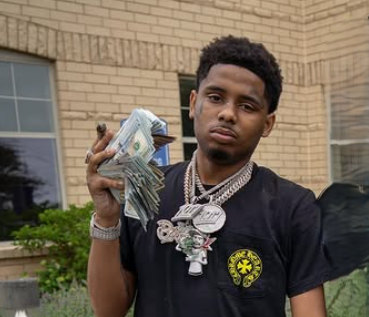Hip-hop’s capacity to turn chaos into money is demonstrated by Pooh Shiesty’s estimated net worth of $3 million in 2025. His story is remarkably similar to that of other incarcerated musicians who have maintained momentum: after spending almost three years in federal prison, he has significantly strengthened his brand value, confounded assumptions that his career would be halted, and exited financially unscathed.

Pooh Shiesty, who was born Lontrell Donell Williams Jr. in Memphis, Tennessee, quickly gained notoriety for his ferocious delivery, unvarnished lyrics, and remarkably genuine Southern vigor. His breakthrough single, “Back in Blood,” which he co-wrote with Lil Durk and became a cultural anthem, peaked at number 13 on the Billboard Hot 100 in 2020. Shiesty’s position in hip-hop was cemented by the song’s success, which provided a rough counterpoint to the polished mainstream sound.
Pooh Shiesty – Personal and Professional Snapshot
| Attribute | Details |
|---|---|
| Full Name | Lontrell Donell Williams Jr. |
| Stage Name | Pooh Shiesty |
| Birthdate | November 8, 1999 |
| Birthplace | Memphis, Tennessee, USA |
| Profession | Rapper, Songwriter |
| Affiliated Labels | 1017 Records (Gucci Mane), Atlantic Records |
| Breakthrough Single | “Back in Blood” featuring Lil Durk |
| Mixtape Release | Shiesty Season (2021) |
| Legal Challenges | Sentenced to 63 months; released early after ~3 years |
| 2025 Estimated Net Worth | $3 million |
| Income Sources | Music sales, Streaming, Guest Features, Merchandise |
Shiesty joined a group of rappers who climbed through carefully crafted underground routes into the commercial spotlight by signing with Gucci Mane’s 1017 Records. Gucci’s label, which has a remarkable knack for finding talent from the streets, has previously supported artists like Big Scarr and Foogiano. Shiesty’s inclusion on this roster wasn’t a coincidence; rather, it reflected a larger hip-hop trend in which marketability is frequently driven by authenticity. Shiesty Season, which peaked at #3 on the Billboard 200 and further cemented his fame, was released within months.
Despite being small, Shiesty’s discography turned out to be remarkably diverse. His follow-ups, such as “Neighbors” and “SUVs (Black on Black),” added platinum and gold plaques to his wall, even though “Back in Blood” received five RIAA platinum awards. Multiple revenue sources were produced through partnerships with Lil Baby (“Shiest Talk”), Megan Thee Stallion (“Who Me”), and Lil Durk (“Should’ve Ducked”). Cross-audience monetization is exemplified by the steady revenue made possible by these features, which are frequently backed by backend royalties and advances.
However, his legal issues increased in tandem with his velocity. Shiesty was arrested in 2021 on federal conspiracy and firearms charges related to an event that occurred in Florida in 2020. In 2024, he was released into a halfway home after serving roughly three of the five years he was ultimately sentenced to. Under comparable conditions, many musicians lose their fan following, but his fan base remained surprisingly devoted. Millions of people listened to his music each month, demonstrating how digital platforms can support careers even when people are not around.
During his imprisonment, merchandising became his lifeline. Through the selling of shirts, hoodies, vinyls, grinders, and socks, Shiesty’s team was able to keep fans interested by utilizing his recognizable branding and street appeal. In addition to generating steady income, this merchandise line—which was incredibly effective in terms of demand and logistics—also preserved his reputation during a time of physical silence.
Online rumors regarding Shiesty’s comeback were prompted by footage of him that surfaced after his release, frequently in the form of shaky, grainy footage shot in parking lots or retail establishments. Every video became an event that was passionately discussed on social media. Even though they were fleeting, these moments served as poignant reminders of how an artist who is technically confined nonetheless manages to navigate public life. His positioning of the home halfway may restrict movement, but it hasn’t lessened cultural significance or interest.
Hip-hop’s continuous experimentation with legal drama, atonement, and resiliency is reflected in Shiesty’s journey. He joins a growing number of rappers whose legal dramas have captured the attention of fans and news cycles, including Young Thug, Gunna, and Tay-K. Today’s digital environment enables artists to maintain active presences, thanks to automation, fan culture, and streaming economics, in contrast to previous decades when incarceration almost always silenced careers. The fact that music marketers are now actively incorporating this change into long-term strategy is very inventive.
Shiesty sees equal parts opportunity and risk in the upcoming phase. Reintegration involves more than just re-recording; it’s also about rebuilding relationships with collaborators, avoiding any legal blunders, and dealing with a market that is increasingly dominated by viral trends and short-form material. This comeback could happen much more quickly than most if it is managed carefully. A docuseries or mixtape that is emotionally honest—perhaps focusing on his thoughts while incarcerated—could transform adversity into a compelling story.
